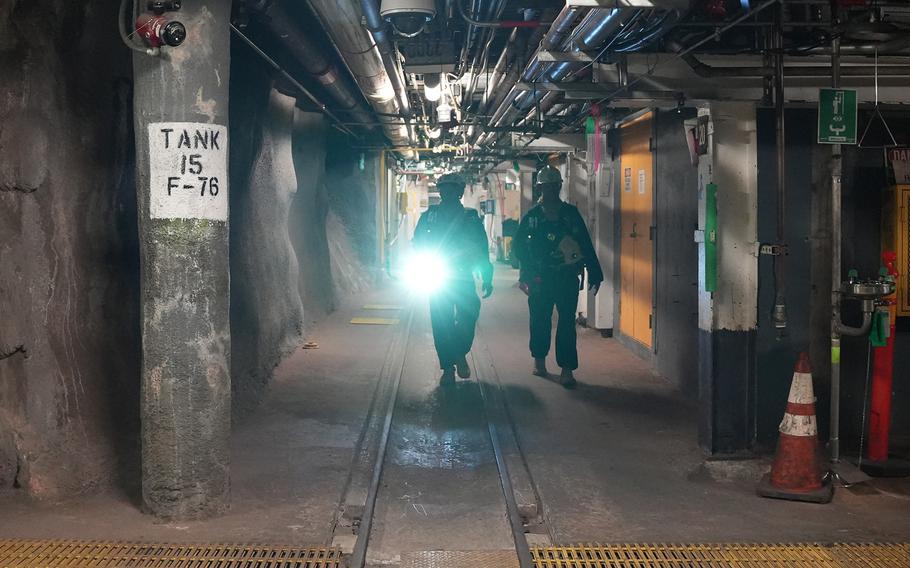
Joint Task Force-Red Hill roving security and fire watch team members patrol the Red Hill Bulk Fuel Storage Facility, Halawa, Hawaii, on Sept. 6, 2023. (Nicholas Brown/U.S. Air Force)
(Tribune News Service) — The Pentagon has officially told Congress that military operations in the Pacific will not be adversely affected by the closure of the Navy’s underground Red Hill Bulk Fuel Storage Facility.
During a news briefing on Tuesday, Pentagon press secretary Brig. Gen. Pat Ryder said that the notification “reflects the department’s ongoing commitment to defuel and ultimately close the Red Hill Bulk Fuel Storage Facility, while upholding our responsibility to ensure the readiness of our armed forces.”
The report was required by Section 331 (c) of the National Defense Authorization Act for Fiscal Year 2023. The provision states that the secretary of defense must first certify to the congressional defense committees that defueling the facility won’t adversely affect the military’s ability to fuel its Pacific operation before the military can begin draining the 104 millions of fuel in the tanks — which sit just 100 feet above a critical aquifer that most of Honolulu relies on for drinking water.
The Pentagon currently considers the Pacific its top-priority theater of operations as tensions simmer with China. Much of the focus has been on the South China Sea, a critical waterway that more than a third of all international trade moves through.
China claims nearly the entire sea as its exclusive territory, over the objections of neighboring countries, and has built bases on disputed reefs and islands to assert those claims. Chinese forces have also har assed and occasionally attacked fishermen and other maritime workers from neighboring countries.
The U.S. Pacific Fleet for its part has been conducting nearly constant “freedom of navigation“ operations in the region over China’s objections. Those operations require millions of gallons of marine diesel and jet fuel to power ships and aircraft.
But for years environmental and Native Hawaiian groups, along with several state and county officials, warned that storing millions of gallons of that fuel at Red Hill over the aquifer was a threat to Oahu’s water supply. Navy officials argued that the facility was critical for fueling its vast Pacific operations and insisted that the aging World War II-era was perfectly safe.
Built underground during the war inside a mountain Native Hawaiians call Kapukaki, it was designed to make it impossible for enemy forces to attack. But its subterranean nature also came with maintenance and operations challenges.
In November 2021 fuel from the facility contaminated the Navy’s water system that serves 93,000 people, including service members and their families along with local civilian families that live in former military housing areas. Many fell ill and were forced to leave their homes for months.
After months of resisting a state emergency order to drain the tanks, Defense Secretary Lloyd Austin announced in March 2022 that the military would defuel and permanently close the facility. Later that year, after acknowledging the facility that for years it had insisted was safe had fallen into deep disrepair and would require numerous fixes and repairs to safely remove the fuel, the Pentagon stood up Joint Task Force Red Hill under Vice Adm. John Wade to make those repairs and ultimately defuel the tanks.
In Red Hill’s place the military plans to move toward a “distributed“ fueling plan, spreading its fuel reserve to facilities across the Pacific and in “afloat locations“ aboard fuel tankers. After years of insisting the Red Hill was critical, top Pentagon brass now argue the distributed posture would make supply lines more “resilient“ and give forces in the region more flexibility.
But many local environmental advocates worried that the provision requiring the defense secretary to assure Congress that the move wouldn’t affect operations would give the Pentagon a loophole to back out of its pledge to shutter Red Hill. U.S. Sen. Mazie Hirono, D-Hawaii, who sits on the Senate Armed Forces Committee, said the provision was insisted on by Republican lawmakers and included as a compromise to get other provisions passed.
“This notification serves as a testament to the unwavering commitment of the (Department of Defense) to prioritize safety, environmental stewardship, and the well-being of the communities in Hawaii,“ Wade said in a Tuesday news release. “It is important to assure the community of our promise to safely defuel and close the facility, and the notification to Congress clearly demonstrates our commitment to this endeavor.”
JTF Red Hill’s defueling of the storage tanks is scheduled to begin Oct. 16, with most of the fuel expected to be removed by the end of January.
“This is a good sign that we are finally moving forward with defueling,“ said Wayne Tanaka, director of the Sierra Club’s Hawaii chapter. “However, the certification requirement was both unnecessary and an affront to the people of Hawaii, who continue to be at risk every single day that fuel remains in Kapukaki. The Pentagon already conceded in 2022, after years of gaslighting and denials, that the Hawaii community was correct all along — that the Red Hill Facility was unacceptably dangerous, outdated and unnecessary for its regional fueling needs.”
Tanaka said that “federally imposed hurdles like this demonstrate that our lives still remain subject to the uninformed whims of senators and decision makers thousands of miles away, and will continue to be unless and until much more of us take action for military and federal accountability to our aina, our people and our dignity.”
(c)2023 The Honolulu Star-Advertiser
Visit The Honolulu Star-Advertiser
Distributed by Tribune Content Agency, LLC.